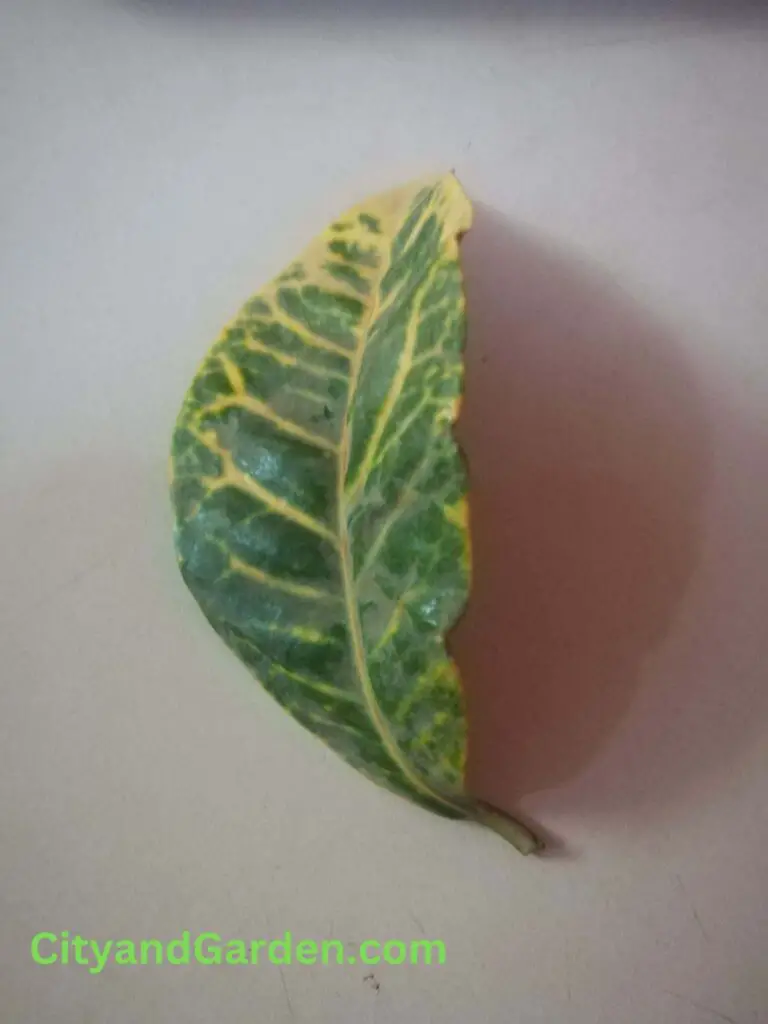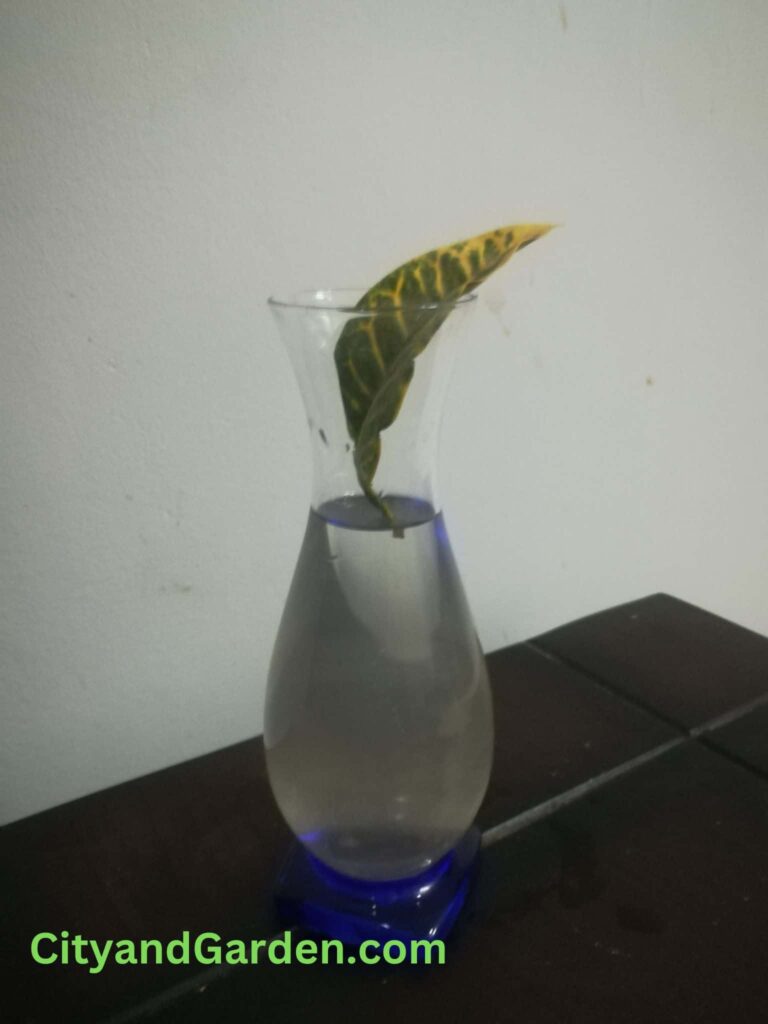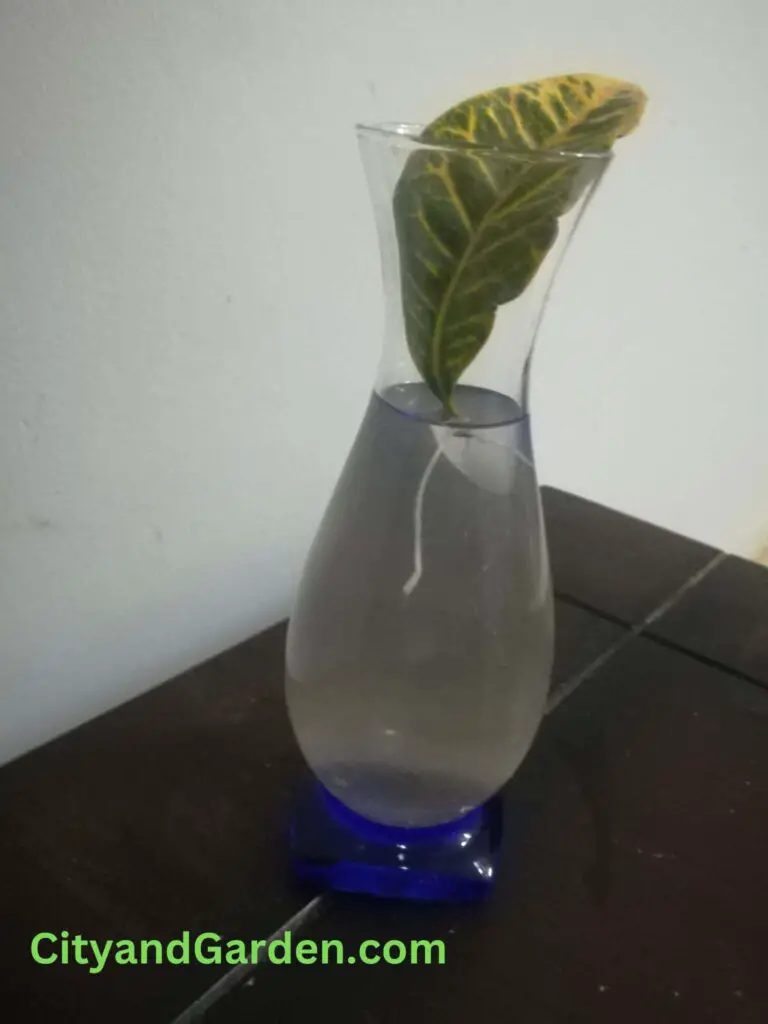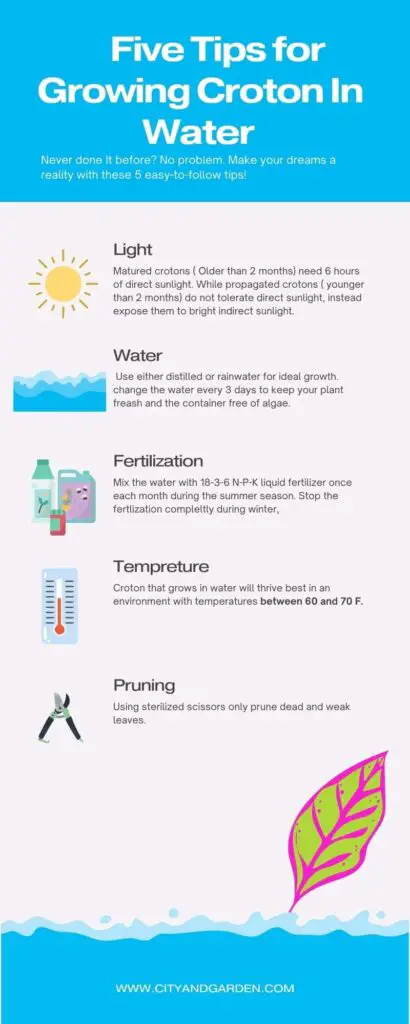Croton is one of the most beautiful houseplants. It will be great if you can add it to your water garden. So you are wondering: Can croton grow in water?
In this article, we will discuss how you can grow croton in water and the benefits of doing so. But before diving deep into the details we will put the answer to our main question as simple as this: can croton grow in water? Croton can grow and live in water indefinitely if you changed its water occasionally and give it the right growing conditions like temperature, fertilization, and light. Keep reading to know how.
How to propagate croton in water
There are plants that can not be propagated nor grow in water because of their stem nature. Such plants like cast-iron plants. But luckily croton is not one of those plants.
Croton can be propagated either in soil or in water. Soil propagation is straightforward. just cut about 4 to 5 inches a stem from an established croton plant.
Then plant the stem in the soil. After 4 weeks your new plant will form roots under the soil and it will be a well-established plant.
Water propagation is easy too. There are two ways to propagate croton in water. Either by stem cutting or leaf. Both ways are valid. The following instructions for both ways:
Step 1:
For stem propagation :
Cut a stem that is about 4 to 5 inches from an established croton plant. Cut all the leaves from the stem in order to let it focus on growing roots rather than feeding its leaves.
For leaf propagation:
Cut a healthy leaf from an established croton plant. Make sure to cut the leaf with its base ( the part that connects the leaf with the stem).

Step 2:
Whether you choose to do the leaf or the stem method. Allow the cutting or the leaf base wound to dry out. Put your cutting or leaf in a dry and shaded place for two days.
Step 3:
Bring a clear water container and fill it with the water to the extent that will allow only one inch of the stem cutting or leaf base to be submerged under the water.
It is better to use rainwater or distilled water. Because tap water contains too many salts and minerals that may hinder your plant’s growth.
If you don’t have access to such kind of water at least process your tap water before using it. You do so by putting tap water in an open container for 24 hours for some treated chemicals to dissipate in the air.
Step 4:
Put your future plant in the water container. As I mentioned in the previous step, only submerge one inch of the leaf base or the stem-cutting base ( see the below picture).

Step 5:
Wait for 4 weeks. After four weeks your new croton will form a well-established root system under the water.

Now, you can choose either to let your croton live in the water or to move it to the soil. If you want to transplant it in soil. Pull it from the water and put it in a dry and shaded place for two days.
In order for the roots to dry out. Such a thing will decrease the odds of your plant’s roots rotting when you planted in the soil. Also, make sure to use a potting mix that has good drainage properties.
How long croton can grow and live in water
Croton can grow and live in the water indefinitely as long as you provide it with the right conditions. keep reading to know how to do it.
Caring for croton that growing and living in water permanently
Changing the water:
Using a clear water container has advantages that I will discuss later in this article. But it will also make the water a good environment for the algae to grow.
Because sunlight will penetrate the container and reach the water. Therefore, changing the water every three days will keep your plant fresh and the container free of algae.
Light
During the initial stage ( first two months) put your plant container in a spot that gets bright indirect sunlight. Also if you can expose it to 2 to 3 morning sunlight it will appreciate it.
But it is not a must. While your plant matures it will demand more direct sunlight. After two months , put it in a place that gets 6 to 8 hours of direct sunlight.
In order to have colorful croton. Putting your croton in a south or west window will give it what it wants.
Temperature
Your croton that grows in water will thrive best in an environment that has temperatures between 60 and 70 F. At such a temperature, it will flourish and have colorful leaves. Although it will survive at a temperature of 25 F. But not less than that.
Fertilization
feed your croton with fertilizer that relatively has high nitrogen content. liquid fertilizer of N-P-K of 18-3-6 is ideal.
Only fertilize your croton in summer ( during the growing season). Mix only 1/4 of the fertilizer’s manufacturer-recommended dose with water and pour it into the croton container.
Apply the fertilizer only once every month during summer. And stop the fertilization completely in winter as your croton is focusing on resting rather than growth during such period.
Pruning
Your croton plant while it is living in water it will appreciate pruning because it will encourage growth by channeling the plant’s resources only to the young and healthy leaves. Only prune unhealthy and daying leaves. And avoid excessive pruning at once because it will stress your plant.

Moving croton to a new water container
As long as you followed the above caring tips you don’t need to move your plant to a new container except when roots outgrow your current water container.
Through time the croton roots will grow underwater beyond the container capacity. So to a void rootbound move your plant to a new water container.
But make sure the new setup is just like the old one in terms of the plant’s parts that are underwater and the ones that are not contacting the water ( the water height level in the stem should be the same ).
Advantages of growing croton in water
When you grow croton in water permanently you minimize the odds of the pests’ infections. Because there is no soil to accommodate those pests.
Also, growing croton in water will allow you to arrange it as you like. you can have a denser plant by putting more stems in the water container.
And it will lower the plant’s maintenance requirements. You don’t need to water your plant anymore.
Finally, by using a clear and transparent water container you can see the roots. So your response to root rot will be faster when compared if you plant it in the soil.
Why is my croton plant not growing roots in water?
The reason for you not seeing your croton plant rooting underwater can be one of the bellow reasons:
- The croton stem or leaf you picked for propagation is not healthy ( either old or sick).
- You cut the stem without its node or the leaf without its base.
- Your plant is located in a location that is either dark or exposed to direct sunlight during the first two months.
- You didn’t give it enough time, roots will emerge in 4 weeks.
- You used unprocessed Tap water. Only use rainwater, distilled water, or processed tap water.
- You exposed croton to the wrong temperature ( out of the 60 – 70F range ).
In conclusion
In this article, I hope I answered one of my reader’s most frequently asked questions: “can croton grow in water?” Croton can be propagated successfully in water either by leaf or stem cutting.
Also, croton can live and grow in water indefinitely without a time limit. As long as it gets the right amount of light, fertilization, and temperature requirements.
Also growing croton in the water has advantaged such as fewer pest infections, fast response to root rot, and better arrangments.
Also, there are other plants that can grow in the water perfectly, plants like ferns, string of pearls, dracaena, Jade plants, and bromeliads. I wrote an entire chapter about growing plants in water in my book Container Gardening: A Step-by-Step Practical Guide. Download your copy now through this link to master water gardening and container gardening in general.

